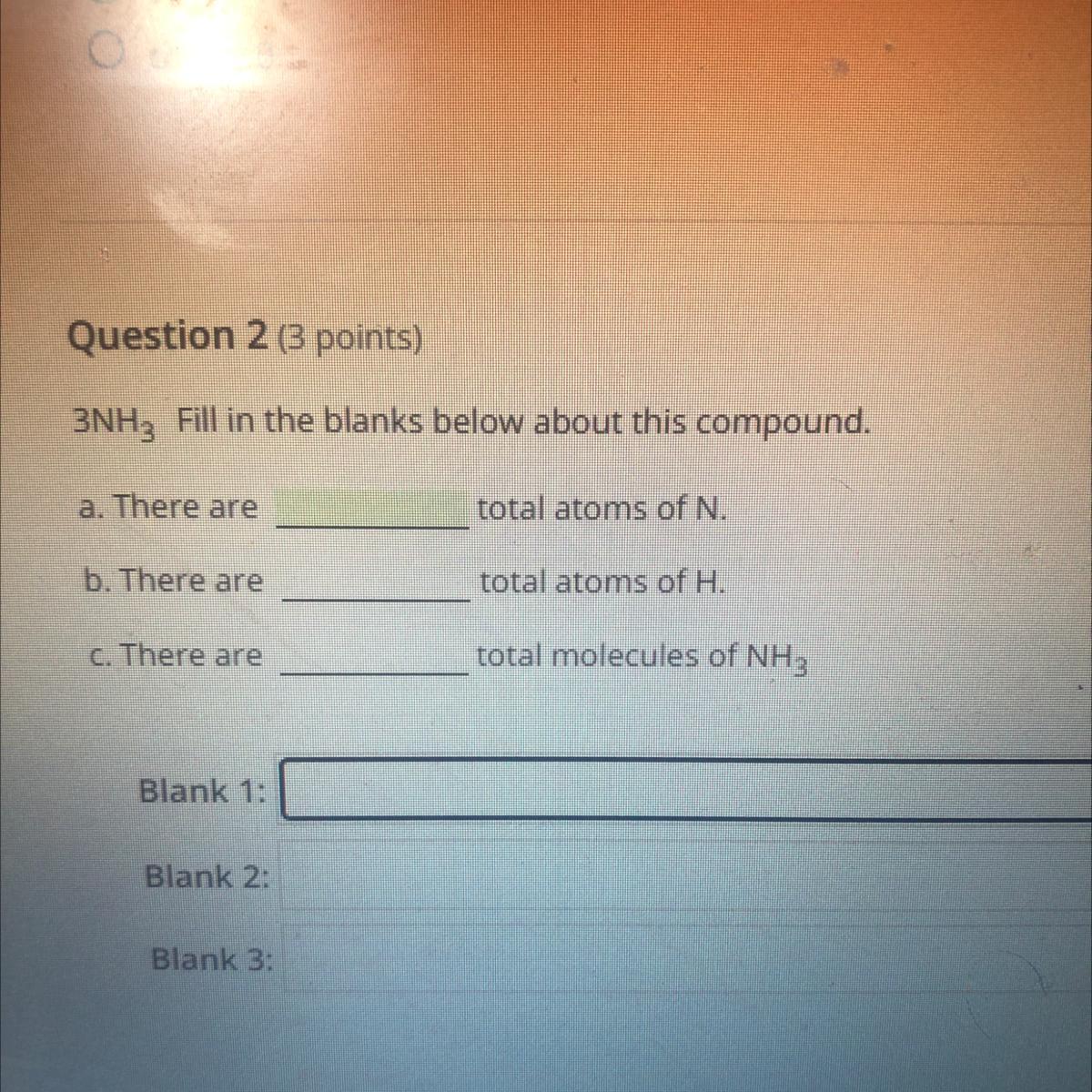Answers
Answer:
3, 9, 3
Explanation:
The coefficient of 3 tells us that there are three molecules (the chemical unit of NH3). Each molecule of ammonia (NH3) is made up of 1 atom of nitrogen bonded to 3 atoms of hydrogen.
Since there are three molecules, we have three times the amount of atoms there are in one molecule.
3 x 1 = 3 nitrogen
3 x 3 = 9 hydrogen
Related Questions
At what minimum temperature do rocks melt into lava?
A) 3,500 degrees Celsius
B) 6,332 degrees Fahrenheit
C) 800 degrees Fahrenheit
OD 800 degrees Celsius
Answers
How many atoms are in 90.43 moles of copper
Answers
Mole measure the number of elementary entities of a given substance that are present in a given sample. Therefore, 8.12×10²³ atoms are in 90.43 mole of copper.
What is mole?
The SI unit of amount of substance in chemistry is mole. The mole is used to measure the quantity of amount of substance. It measure the number of elementary entities of a given substance that are present in a given sample. There are so many formula for calculating mole.
we know one mole of any element contains 6.022×10²³ atoms which is also called Avogadro number
number of atoms/molecules=number of moles × 6.022×10²³(Avogadro number)
number of moles of copper=90.43 moles
Substituting all the given values in the above equation, we get
number of atoms/molecules= 90.43 × 6.022×10²³
number of atoms/molecules=8.12×10²³ molecules
Therefore, 8.12×10²³ atoms are in 90.43 mole of copper.
To know more about mole, here:
https://brainly.com/question/15209553
#SPJ2
An empty steel container is filled with 2.0 atm of H₂ and 1.0 atm of F₂. The system is allowed to reach equilibrium according to the reaction below. If Kp = 0.45 for this reaction, what is the equilibrium partial pressure of HF?
Answers
The equilibrium partial pressure of HF is 0.55 atm.
The equation of the reaction is;
H2(g) + F2(g) ⇄ 2HF
I 2 1 0
C -x -x +x
E 2 - x 1 - x x
We know that;
pH2 = 2.0 atm
PF2 = 1.0 atm
pHF = ??
Kp = 0.45
So;
Kp = (pHF)^2/pH2. pF2
0.45 = x^2/(2 - x) (1 - x)
0.45 = x^2/x^2 - 3x + 2
0.45(x^2 - 3x + 2) = x^2
0.45x^2 - 1.35x + 0.9 = x^2
0.55 x^2 + 1.35x - 0.9 = 0
x = 0.55 atm
Learn more about equilibrium: https://brainly.com/question/3980297
A severe storm would be most likely to damage a coastal area by causing
A.
volcanoes.
B.
pollution.
C.
erosion.
D.
earthquakes.
Answers
my teacher told me
A severe storm would be most likely to damage a coastal area by causing pollution. Therefore, the correct option is option B.
What is coastal area?The region where land joins the ocean, or even as a line defining the border between the land as well as the shoreline, is known as the coast, sometimes referred as the coastline and seashore. The terrain of the area's surroundings has an impact on shorelines, as do water-induced erosion processes like wave action.
The length of the shoreline on Earth is about 620,000 kilometers. Natural ecosystems' coasts are significant zones and frequently the site of a diverse range of biodiversity. They are home to significant ecosystems on land, such as freshwater and estuarine wetlands, that are crucial for the survival of bird populations or other land animals. A severe storm would be most likely to damage a coastal area by causing pollution.
Therefore, the correct option is option B.
To know more about coastal area, here:
https://brainly.com/question/14105067
#SPJ3
Calculate the pH of each of the following aqueous solutions. (Enter your answers to two decimal places.) (a) 10.0 mL deionized water WebAssign will check your answer for the correct number of significant figures. 2.72 Incorrect: Your answer is incorrect. (b) 10.0 mL deionized water plus 5.0 mL of 0.10 M NaOH WebAssign will check your answer for the correct number of significant figures. (c) 10.0 mL deionized water plus 10.0 mL of 0.10 M NaOH WebAssign will check your answer for the correct number of significant figures. (d) 10.0 mL deionized water plus 15.0 mL of 0.10 M NaOH WebAssign will check your answer for the correct number of significant figures.
Answers
Answer:
a. pH = 7.0
b. pH = 12.52
c. pH = 12.70
d. pH = 12.78
Explanation:
a. Deionized water has the [H⁺] of pure water = 1x10⁻⁷ (Kw = 1x10⁻¹⁴ = [H⁺][OH⁻] - [H⁺] = [OH⁻ -)
pH = -log[H⁺] = 7
b. Moles NaOH = 5x10⁻³L * (0.10mol / L) = 5x10⁻⁴moles OH⁻ / 0.015L = 0.0333M = [OH⁻]
-Total volume = 10mL+5mL = 15mL = 0.015L
pOH = -log[OH⁻] = 1.48
pH = 14-pOH
pH = 12.52
c. Moles NaOH = 0.010L * (0.10mol / L) = 1x10⁻³moles OH⁻ / 0.020L = 0.0500M = [OH⁻]
-Total volume = 10mL+10mL = 20mL = 0.020L
pOH = -log[OH⁻] = 1.30
pH = 14-pOH
pH = 12.70
d. Moles NaOH = 0.015L * (0.10mol / L) = 1.5x10⁻³moles OH⁻ / 0.025L = 0.060M = [OH⁻]
-Total volume = 10mL+15mL = 25mL = 0.025L
pOH = -log[OH⁻] = 1.22
pH = 14-pOH
pH = 12.78
Which change represents an oxidation reaction?
